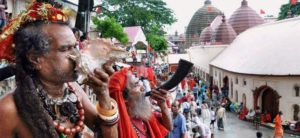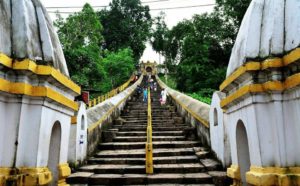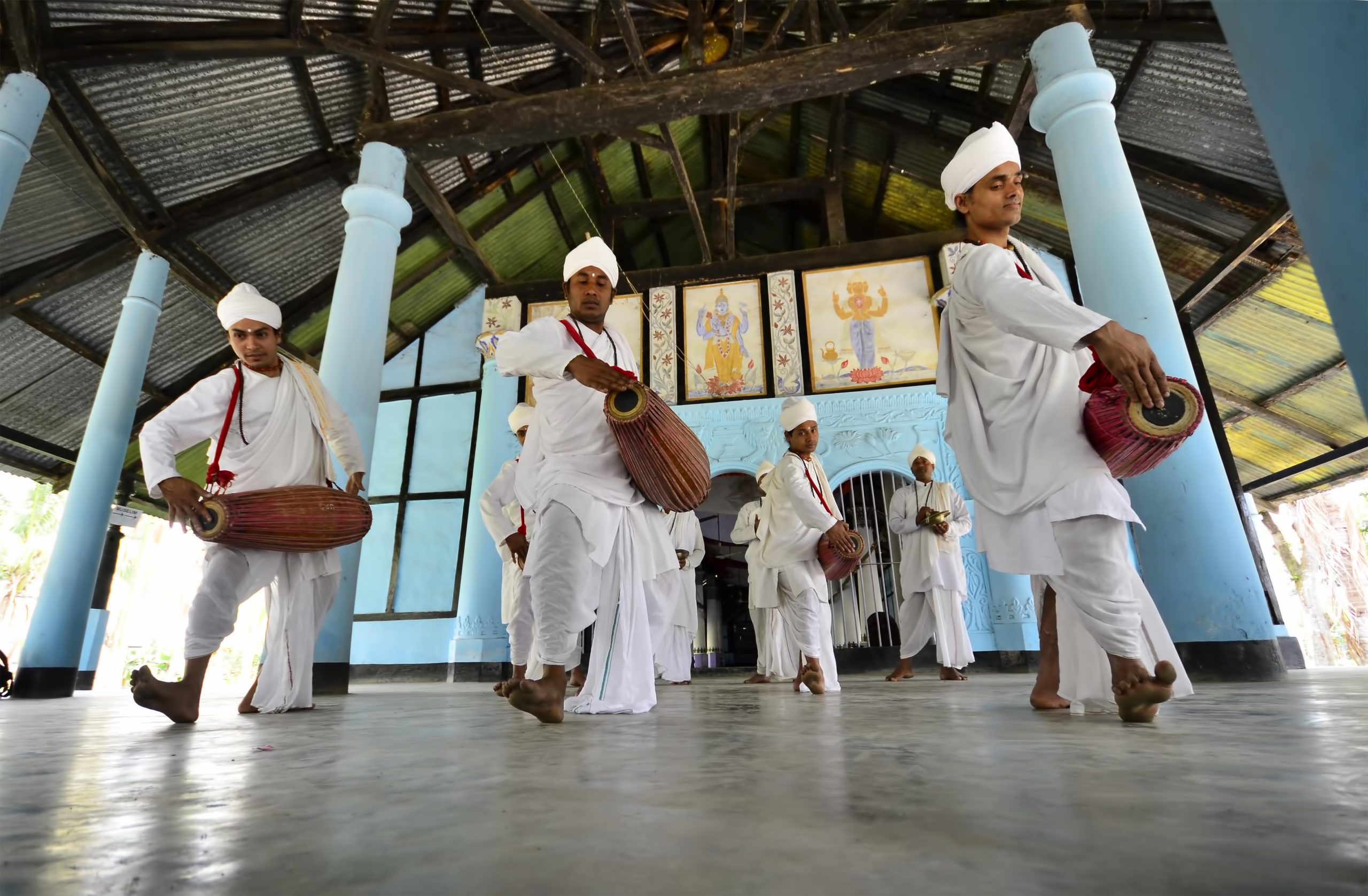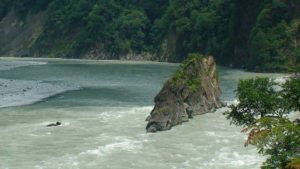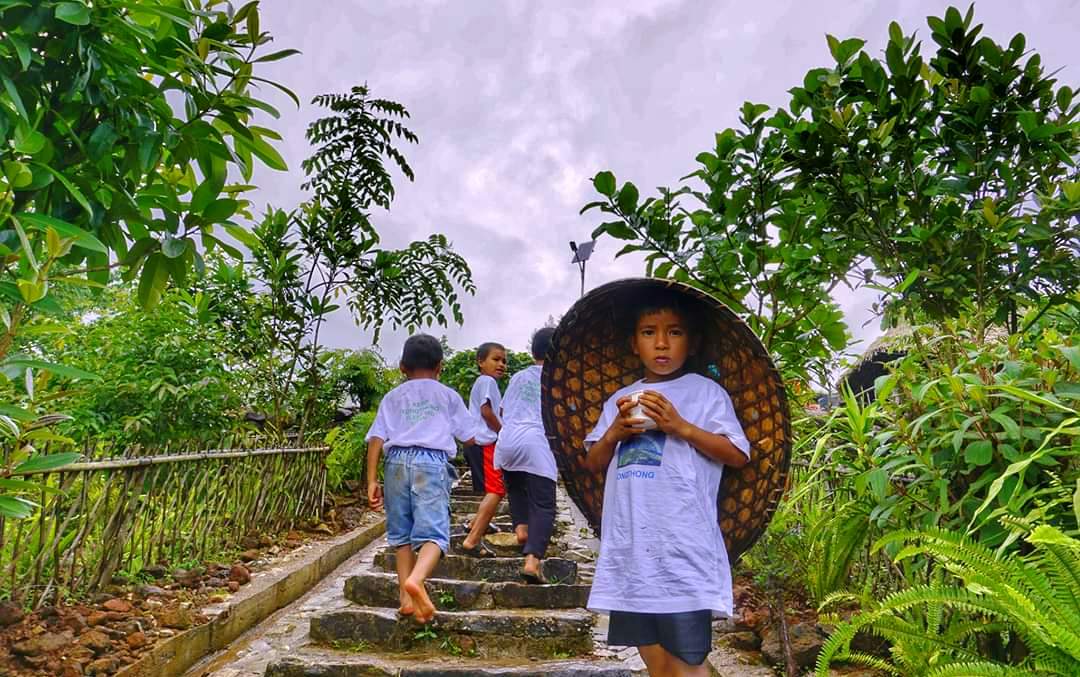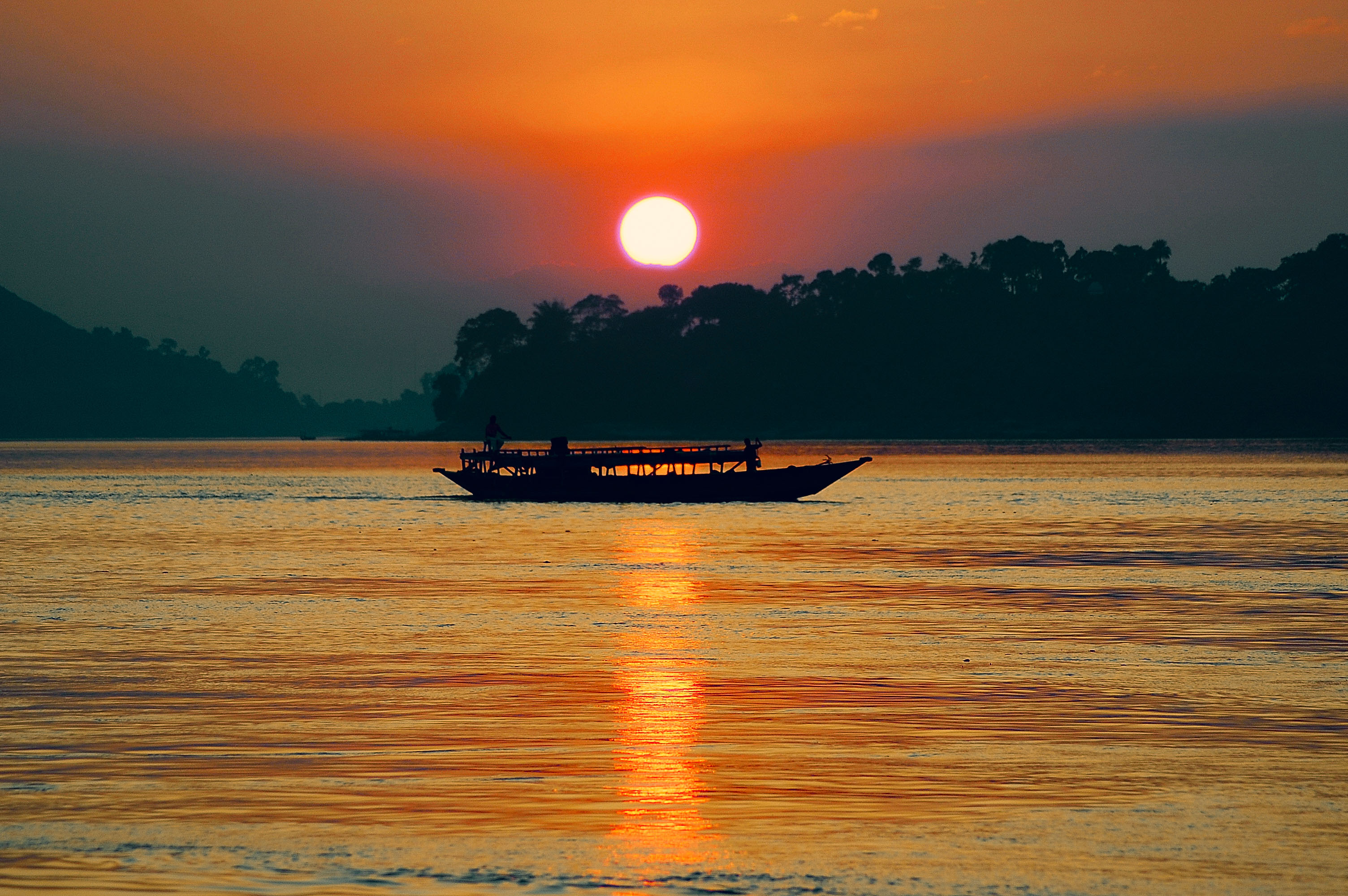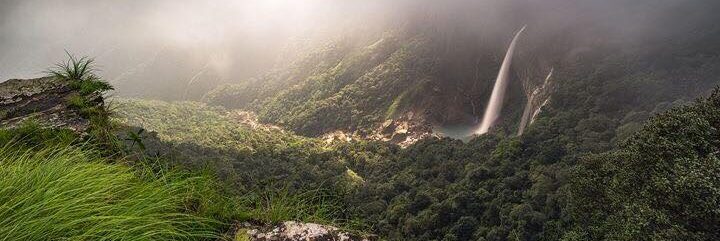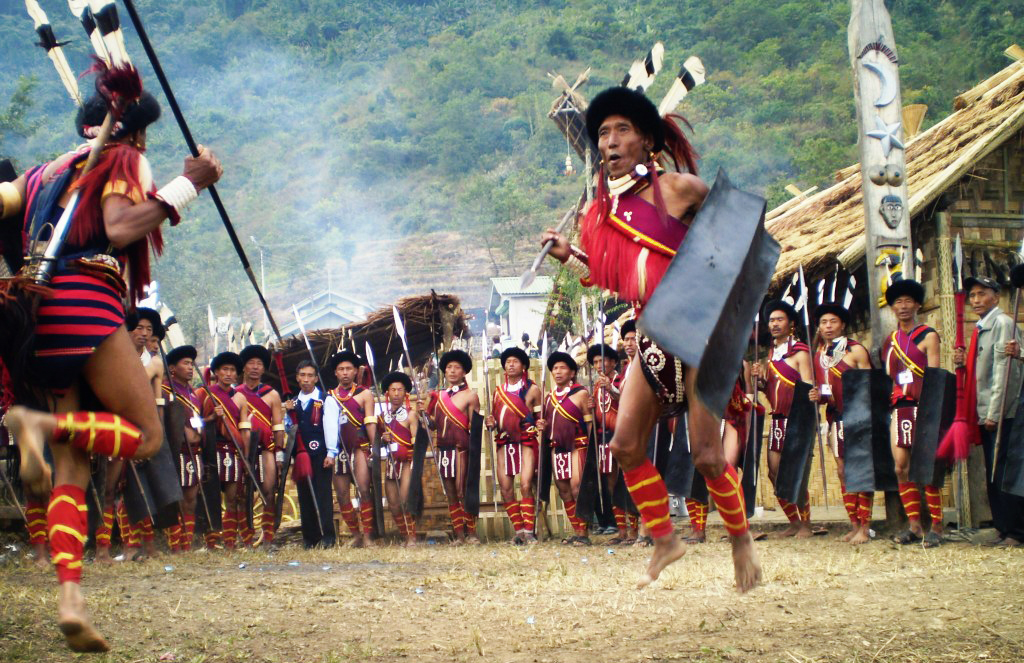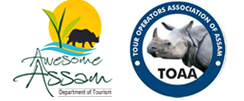Tour Highlight
- Sadhus at Kamakhya Temple during Ambubachi Festival
Pay a Visit To The Kamakhya Temple, Which Is In The Wishlists Of Every Traveller Whoever Come To Guwahati And Seek The Blessings Of Goddess…. A True Celebration Of Womenhood
- Hayagriva Madhab Temple Hajo
Whether you are a believer, an agnostic or an atheist, you can’t deny how your spirits and senses feel elevated when you visit the ancient and magnificent temples of Assam located in the serene environment
- Gayan Bayan performed by the Monks in Majuli
Witness the Vaishnava Monks in Majuli offer pujas to Lord Vishnu and experience the GAYAN BAYAN and SATRIYA DANCE – perform by them to honor the deity.
- Parshuram Kund
A visit to Parshuram Kund will give you the chance to get indulge in meditation and introspection amid its pristine surroundings and get home an everlasting experience of savouring heavenly nature.
Itineraries
Day 01: Arrive Guwahati
Arrrive Guwahati by flight.
Meeting upon arrival and transfer to hotel.
Guwahati: Guwahati is Situated on the Southern bank of the mighty River Brahmaputra in Kamrup district of Assam. Previously it was known as Pragjyotishpur (The City of the eastern Light) Guwahati is the fast growing premier city and it is also the gateway to the North Eastern states of India.This city subsequently got the name Guwahati (Guwa-means beetlenut and Hat –means market in Assamese)
Evening enjoy the sunset cruise in Brahmaputra river (OPTIONAL: Rs. 450 PER PERSON).
Overnight at hotel.
Day 02: Guwahati
Morning after breakfast visit the Nilachal Hills which is known as the home to the Tantra (Black Magic) and the most sacred Temple in this part of the country. In Nilachal Hill, visit:
Kamakhya Temple: The origin of Kamakhya Temple is pre Aryan situated atop the Nilachal Hill. The formost shrine of Assam, The Kamakhya is an ancient seat of Tantric and shakti Cults of Hinduism. The original temple was destroyed by the invading Muslims in their crusade against Hindu temples and idols in the early part of 16th century. Ultimately it was restored from ruins by King Naranarayan of the Koch dynasty and rebuilt in its present forming 1665 AD.
Chhinnamasta : The Chhinnamasta temple is situated adjacent to the Kamakhya temple. The goddess is also known as Gupta Durga. Devi cut her own head and carried in her hand.
Bhairabi temple : Bhairabi temple is situated in the lower portion of Nilachal hill. The floor area of the temple is said to be on human skulls. In each night of Full Moon and Dark Moon, the priests offer puzas to Devi Bhairabi in tantrik system. The pond in the temple complex is full of tortoises population of very old times. When called as ‘Mohan’ with some food-stuff they rush towards the beach to get it.
Bagala temple : The followers of tantras offer puja in the Bagla temple. There is a common belief that Bagala Devi provides mental peace and relief to the devotees, when confronted by evils and foes.
Later return to Hotel.
Overnight at hotel.
Day 03: Guwahati
Morning after breakfast visit:
Umananda Temple: In the vicinity of Guwahati in the middle of the river Brahmaputra on an island hill stands the temple of Shiva ‘Umananda’ (also known as Peacock Island). It is also known as ‘Bhasmachal’ as the rays that emanated from his forehead reduce4d Kamdev to ashes. Within the temple are to be seen the images of Anandi Shiva Linga and a silver ox and Umananda with five faces and ten hands.
Navagraha Temple: To the extreme east of Guwahati on the Chitrachal Hills stands the Navagraha Temple (Temple of Nine Planets) is a center of Astrological and Astronomical research. The govt raised some quarters here and as a result of excavation twelve Shiva Temples have been un earthed.
Shankardev Kalakshetra: a place where Assamese history and culture is depicted in a sprawling open enclosure. It has a beautiful museum where they preserved the masks (these masks are made in Majuli island), the traditional dresses and jewellery of the entire North East India. A Namghar (Assamese prayer Hall) and an open air theatre has been constructed to perform the plays and other cultural activities during festivals.
Vasistha Ashram: This Ashram was established by the great sage Vasistha on Sandhyachal Hill. By the force of penance and meditation Vasistha, the sage had brought Ganges in three flows called ‘Sandhya’, ‘Lalita’, and ‘Kanta’. The sage Vasistha every day offered worshipped at the confluence of the three courses of Ganges. Many people assembled during eclipses (Solar & Lunar).
Ugro Tara Temple: Ugro Tara Temple is a temple dedicated to Tara (Devi) located in the western side of Jor Pukhury tanks in the heart of Guwahati city in the Lotaxil (Latasil) locality in Northeast India. The Ugratara Temple in Uzan Bazaar in the eastern part of Guwahati, Assam is an important Sakti shrine. Legend has it that the navel of Sati, first consort of Shiva, is related to this temple. Ugratara in Assam is generally identified with Tiksna-Kanta, Eka-Jata, etc., of the Buddhist pantheon.
The present temple of Ugra Tara was built by Ahom King Siva Singha in 1725 AD who had excavated a tank three years before. The tank, known as Jorepukhuri, is situated to the east of the temple. The tank still exists, though the upper section of the temple was destroyed by a devastating earthquake. This was however rebuilt by a private citizen.
Kalika purana describes a Shakti peetha called Dikkara vasini. Dikkara vasini has two forms, Tikshna kantha and Lalitha kantha. Tikshna kantha is black and pot bellied, also called as Ugra Tara or Eka jata. Lalitha kantha is gracefully attractive, also called as Tamreshwari.
In the garbhagriha of Ugra Tara there is no image or idol of her. A small pit filled with water is considered as the Goddess. The temple of Ugra Tara is small and beautiful to view. There is a Shivalaya beside Ugra Tara temple and a pond behind both temples.
Rest of the time free at leisure.
Overnight at hotel.
Day 04: Guwahati
Morning after breakfast full day excursion to North Guwahati .
In North Guwahati visit:
Sualkuchi: Sualkuchi is known to be the Manchester of the East and it is famous for the Assam Silk. This place is also known as the “Silk Village”. The ‘Muga’, the golden silk of Assam is made known to the world way back in 1662 by a French traveler Jean Joseph Tavernier. The silk was the royal fabric of the Ahom King who ruled Assam for six centuries till 1826.
Doul Govinda Temple: Doul Govinda Temple is one of the famous temples of Assam. It is situated on the northern banks, on the foot hills of Chandrabharati hill at Rajaduar, North Guwahati. The temple is mainly devoted to Lord Krishna. Besides, there is an Namghar along with the temple within the same premises. Several stories exists regarding this deity and how ‘He’ was brought here by late Ganga Ram Barooah from a place called Sandhyasar near Nalbari. The first structure of Doul Govinda Temple was erected more than one hundred and fifty years ago but it was again renovated in 1966. The Doul Govinda Mandir in Assam is famous for its Holi celebrations in the month of February – March. Holi is observed by the local people for five days with various programme and about five thousand Pilgrims are always assembled at the Mandir premises during this time.
Ashwaklanta Temple: Aswaklanta Temple was built by Ahom King Shiva Singha in 1720. Shiva Singha built most of the biggest Hindu temples of Assam including the famous Shiva Dole of Sivasagar. The temple is situated by the bank of mighty Brahmaputra. There are two temples in that holy place. One situated in the foot hill and the other in the up hill – Kurmayanardan and Anantasayi by name.
The place where the temples were built holds hindo mythological importance. Mythology says that while Lord Krishna searched for Narakasur to kill him, his horse got tired in this place.This is how this place was named Aswa-Klanta. Aswa means ‘Horse’ and Klanta means ‘Tired’ in Assamese. According to another legend, horses belonged to Arjun, the great Pandava and friend of Krishna, were persuaded in this place to stay back from the better scene so that Abhimanyu could get killed. It was a conspirancy and called ‘abhikranta’ in assamese. From this word the place was named as Aswa-krata. And later it became Aswaklanta in popular language.
The temple was damaged in the great earth quake of Assam in 1897. But it was reapired under patronage of lord Kurzon, then viceroy of Assam.
Hayagriva Madhava Temple: Hayagriva Madhava Temple is situated on the Monikut hill. The present temple structure was constructed by the King Raghudeva Narayan in 1583. According to some historians the King of Pala dynasty constructed it in 6th century. It is a stone temple and it enshrines an image of Hayagriva Madhava. Some Buddhists believe that the Hayagriva Mahhava temple, best known in the group of Hindu temples, is where the Buddha attained Nirvana. At this imposing temple, the presiding deity is worshipped as the Man Lion incarnation of Vishnu by the Hindus.[1] It is a stone temple and it enshrines an image of Hayagriva Madhav. The rows of elephants are seen on the body of the temple and they are fine specimens of Assamese art. There is a big pond known as Madhab Pukhuri near the temple. Doul, Bihu and Janmastami festivals are celebrated every year in the temple. Moreover this temple preaches both Hinduism and Buddhism, which attract Buddhist Monks from far flung places. Sayani, the first wife of Kalia Bhomora Borphukan donated a family of paiks and also a plot of land for their maintenance to the Hayagriva Madhava temple during the reign of Ahom king Kamaleswar Singha.
Later return to Gwahati.
Overnight at hotel.
Day 05: Guwahati / Kaziranga (215 Kms, 5 hrs drive)
Morning after breakfast depart for Kaziranga National Park.
Kaziranga National Park: Kaziranga National Park has become synonymous with successful conservations of Great One Horn Rhinoceros (from the Greek word, “rhino” means nose and “ceros” means horn) / Unicornis (from the Latin word, “uni” means one and “cornis” also means horn) and also a home of may other threatened species including Indian Elephant (Elephant Maximus), Tiger(Panthera tigris), Hoolock Gibbon (Bunipithecus hoolock), Ganges dolphin (Platanista gangetica),Sambar (Cervus unicolor), Barasingha or Swamp Deer (duvauceli), Hog Deer, Indian Muntjac (Muntiacus muntjak), Water Buffalo (Bubalus bubalis) and Gaur (Bos frontalis)etc.
There are also over 500 species of birds have been recorder in the park including 25 specis of globally threatened category. Over and above there are 21 rare and endangered species. In winter one can observe a large breeding population of Spot Bill Pelicans about one thousand breeding nests are found in a place which has been named as Pelican Colony in the Eastern Range.
Among the reptiles species like Water Monitor Lizard (Varanus salvator), Indian python (Python molurus), Cobra (Naja naja) and the King Cobra are found.
Arrive Kaziranga and check in at the Jungle Resort.
Overnight at resort
Day 06: Kaziranga National Park
Early morning enjoy the elephant safari in the central (Kohora) range of Kaziranga. Later return to the resort for breakfast.
Afternoon visit the Kaziranga National Orchid and Biodiversity park and witness more that 200 different species of Orchids. Also enjoy the different traditional dance forms and songs along with ethnic foods
Late afternoon enjoy the exclusive Jeep safari in the western (Bagori) range of Kaziranga.
Overnight at the resort.
Day 07: Kaziranga
Morning after breakfast full day excursion visiting:
Hatimura Temple: The present Hatimura temple, at Silghat, in Nowgong district, was probably built on the ruins of an old stone ’temple in the Saka year 1667 (1745-46 A.D.) in the reign of King Pramatt Singh of the Ahom dynasty. It is a brick temple, which still exists although in a very dilapidated condition. The presiding deity of the temple is the Mahisamardini. The goddess is represented with slender waist, broad breasts, ten hands, and holding different weapons in each hand.
She is seen placing her right foot on the lion, and pressing the shoulder of the buffalo demon with her left. She pierces the trident through the body of the demon, and has fastened his arm with a noose. To put her weight on the Asura, the goddess is slightly bent to the left. The lion is also represented attacking the demon. The whole composition of the goddess is as given in the text.
The temple was one of the important centres of Shaktism, in early Assam. At one time even human sacrifices were made at the altars of the temple. A big sword supposed to have been used for human sacrifices has been deposited in Assam Provincial Museum, Guwahati.
Silchat Kamakhya Temple: The famous temple of Goddess Kamakhya is situated in Silghat on the bank of the Brahmaputra river. Constructed during the reign of the Ahom king, Pramatta Singh this temple is counted amongst the important centres of Saktism. Human sacrifices were performed in front of the main altar of the temple. A sword, along with other tools believed to be used for human sacrifices, has been preserved in the Assam State Museum at Guwahati. Every year the Ashok Ashtami mela is held near the temple.
Kako Gosani Than: Kako Gosani Than will the temple of Durga who was carried in a piece of ‘Kako’ bamboo. It is said in 17th century .There was a political crisis in Ahom period in Assam . Then the Ahom king was Sulikpha who was mere a child . His father-in-law Laluksola Borphukan then administered the kingdom . On behalf of the boy king “Lora Raja: . To make the throne safe for him Borphukan began to maimed the Ahom princess so that according to custom they might not be able to demand the throne. But the prince Langi Gadapani alias Gadadhar Singha of Tungkhungia dynasty fled away . His wife Joymoti was severely tortured and killed . In his abscending period Gadadhar Singha carried same golden idols of Devi Durga with him in his bundle of cloth and inside the hollow piece of Kako Bamboo . He used to worship her. One day he was resting under a tree of “Am Tenga” , a kind of acid fruit by “Naramara bill(lake)”. Sunddenly the spies of the king surrounded him . He started and threw one idol to the lake and escaped . This idol was later brought up by the villagers and set up a temple on the Diring river . Now its place has been changed . In the west of Bokakhat it is placed . Durga puza and Basanti Puza are performed here pamparsly. Animal sacrifices even buffalo are also made in these occasion . Daily worship is also going on . People of different religious often visit this temple . Besides the old building a new building has been built recently . A beautiful gate the N.H. 37 indicates its location .
Rest of the time free to explore the beautiful teag gardens of Assam.
Overnight at hotel.
Day 08: Kaziranga / Jorhat (96 Kms, 2 hrs drive)
Morning after breakfast depart for Jorhat
En route visit:
Buhi Gosani Thaan: Burhi Gosani Thaan is a very ancient shrine closely connected with the Ahom king Gadadhar Singha . In his absconding period, once he visited this area .He bought this idol in a bundle of cloth. Once he dreamt that goddess wanted to line in the ‘Jari tree’ . He left her there. Later the villages saw same supernatural incidents and set up a temple there. After offering prayer in this temple many people have got their desire. So out of gratitude they built the brick temple.
Negheriting Shiva Temple: The Negheriting Shiva Doul is a Shiva temple in Dergaon, Assam. Situated on a hillock at about one and half km north from the National Highway 37 in the Golaghat district of Assam, the temple was first constructed by the Kacharis during 8th – 9th century AD. Later due to natural calamities it came into destruction. In 1687 it was re-constructed by Ahom king Swargadeo Rajeswar Singha. The famous architect assigned to the job was Ghanashyam Khonikar.
Arrive Jorhat and check in at hotel.
Evening free at leisure.
Overnight at hotel.
Day 09: Jorhat / Majuli
Morning after breakfast depart for Majuli Island. En route cross the Brahmaputra river by local made ferry.
Majuli Island: The largest inhabitant river line island in the world Majuli has been the hub of Assamese neo-vaishnavite culture and it is the cultural capital and the cradle of Assamese civilization for the past 500 years, by the revered Assamese saint Srimanta Sankardeva and his disciple Madhavdeva. The first vaishnavite monastery was at Belaguri in west Majuli. After that 65 Monasteries (SATRAS) were set up. Today only 22 of the original 65 are survived.
The main tribe of Majuli is Mishing. They comprise of about 47% of the population of Majuli. The term Mishing is also made up of two words- ‘mi’ means people and ‘yassing’ means fine, and that’s why they call themselves fine people. Other comprises Chutias, Deoris, Sonowal Kacharies, Koches, Naths, Kaivarttas, Mattaks, Ahoms, Kalitas, Brahmins etc.
Arrive and check in at traditionally built bamboo hut.
Later explore the traditional roots of Assamese society by visiting the vaishnavite monasteries of Majuli.
Overnight at Bamboo hut.
Day 10: Majuli
Morning after breakfast explore the vaishnavite monasteries of Majuli visiting:
Dakhinpat Xatra: Founded by Banamalidev, a supporter of Raasleela, which is now observed as one of the National Festivals of Assam.
Garamurh Xatra: This “Satra” was founded by Lakshmikantadeva. During the end of autumn, the traditional the Raasleela is enacted with pomp and celebrations. Ancient weapons called “Bartop” or cannonss are preserved here.
Auniati Xatra: Founded by Niranjan Pathakdeva, the satra is famous for the “Paalnaam” and Apsara Dances and also its extensive assortment of ancient Assamese artefacts, utensils, jewellery and handicrafts. It also has a hundred and twenty five disciples and over seven hundred thousand followers worldwide.
Kamalabari Xatra: The Kamalabari Satra, founded by Bedulapadma Ata, is a centre of art, cultural, literature and classical studies on the island. Its branch the Uttar Kamalabari Satra has performed cultural programmes of the Satria Art all around the country and abroad.
Shamaguri Xatra: The satra is famous for the masks making in India.
Overnighht at bamboo hot.
Day 11: Majuli / Sivasagar (70 Kms, 1 hour drive and 2 hrs ferry ride)
Morning after breakfast depart for Sibasagar. En route again cross the Brahmaputra river by local made ferry.
En route visit the beautiful tea gardens of Assam.
Dhekiakhowa Bornamghar: Dhekiakhowa Bornamghar is one of the most revered religious destinations in Jorhat. It was established by saint-reformer Madhavdeva, a disciple of Srimanta Sankardeva at a small village which was later named as Dhekiakhowa.
It is believed that while touring these parts with the idea to reform people, Madhavdeva stopped at a small, unknown village. He asked for shelter at a very poor and old woman’s house. Because of her poverty, she could only offer the great saint rice with Dhekia Saak (a nutritious and easily available leafy vegetable). He was so impressed with the food that he decided to set up namghar (prayer house) in the village. Eventually, the place got its name as Dhekiakhowa (khowa meaning eating).
Arrive Sivasagar and check in at hotel.
Sivasagar: Situaterd 369 Kms east of Guwahati Sivasagar erstwhile Rangpur is full of historic relice. Bearing testimony of 600 years of Ahom rule. Rangpur became THE 4TH Capital of Ahom Kingdom. The name of the town and the district originated from the Sivsasagar Tank and temples.
In Sivasagar visit:
Rang Ghar: An antique two storied imposing structure the Rang Ghar (‘Rang’ means enjoyment ang ‘Ghar’ means house in Assamese language)happened to be the royal sports pavilion (lile wrestling, bird fight, buffalo fight etc) of the Ahom Kings. It was constructed by the 34th Ahom king Pramatta Singha in 1746.
Tolatol Ghar: Originally constructed by the Ahom king Rudra Singha in 1699 the present palace made of bricks and indigenous type of cement constructed by King Rajeswar Singha in 1751-69). Known as the seven storied Kareng Ghar of which four were over ground and remaining three were underground, it was the Capital and the military station of the Ahom kings.
Shiva Dole: The Shiva Dole, Vishnu Dole and Devi Dole constructed by second queen of Shiva Singha known as Ambika in 1734. This reputed to be the tallest Shiva Temple in North East India. The Shiva Dole 180 feet in height and 195 feet in diameter caped by seven feet height golden dome.
Shivasagar Tank (Barpukhuri): Constructed by second queen of Shiva Singha queen Ambika in 1734, covers an area of 129 acres. The water level of the tank never changes and remains above the level of the town all the time.
Kareng Ghar (The Gargaon Palace): The original structure had been made of wood and stones. In 1747 King Pramatta Singha constructed the brick wall of about 5 kms.The present surviving Brick palace was rebuilt by king Rajeshwar Singha in 1752.
Charaideo Maidam: The tombs of King and Queen at Charaideo Hillock are comparable to the pyramids of Egypt. Charaideo was the first Capital of Ahom Kingdom established by King Sui- Ka- Pha. This is also the sacred burial ground of the kings and the queens of the Ahom Kingdom.
Overnight at hotel.
Day 12: Sibasagar / Dibrugarh (70 Kms, 1 hour drive)
Morning after breakfast depart for Dibrugarh.
Later visit:
Tilinga Mandir: Tilinga Mandir of Bordubi, Tinsukia is a famous Shiv’s Temple situated at Bordubi, a small town in Tinsukia District of Assam. Tilinga Mandir is about 20 km Driving Distance away from main Tinsukia town and about 7 km from oil town Duliajan. Tilinga means “bell” in Assamese and mandir means “temple” .This Bell Temple is as spiritually and mystically strong as any other temple. There are hundreds and thousands of bells of all sizes in bronze, brass, copper and aluminum that’s tied to the big banyan tree (pipal) and its various branches. People from various parts of India who heard about this temple have visited this temple. According to Hindu Mythology “Monday” is considered as “Lord Siva’s” day and therefore every Monday a huge number of people gather here to worship Lord Siva. So if you are planning to visit ‘”Tilinga Mandir” for the first time then “Monday” should be the day.
Thai Phakial – (The Tai words ‘Pha’ meaning wall and ‘Ke’ meaning ancient or old.) The Phake is also known as the Phakial, they had migrated from Thailand to Assam in 18th centuary, they speak Thai language. Even during the modern time they still follow their traditional culture. The have a fine tradition to keep their family record, the name of the record is Ho Likboi, generally the elder of the family known as the Pathek is well versed prepare the record. They practice Buddhism, there is a Buddhist monetary in Namphake village established in 1850 the monks in the monasteries is known as CHOW MOUN . They also have the sound knowledge in Pali language. The residence claim to be 100% literate. One interesting fact is that the villager claims the police had never entered the premises as because the Monks settled the disputes among the villagers, they also rely on Herbal cure. They marry within there community only but there is no restriction if someone wants to marry from outside. They are basically patriarchal society the son inherits the fathers property. Though few in number and in spite of an identity crisis, the Tai Phakes have been able to maintain their glorious legacy.
Rest of the time free at leisure.
Overnight at hotel.
Day 13: Dibrugarh / Parashuram Kunda / Dibrugarh
Morning after breakfast visit:
Parashuram Kunda: Parasuram Kunda, a place of pilgrimage is situated in the bank of the river Lohit at about 24 Kms from Tezu. It is also known as ‘Prabhu Kuthar’, the origin of the ‘Kunda’ viz. Parasuram Kunda is associated with Parasuram’s matricide. The history goes in brief that one day Renuka, mother of Parasuram went to Ganga for having bath and bringing water. But delay in bringing water made the Rishi Jamadagni, the husband of Renuka very angry as it was already getting late for the mid day worship. He asked the sons to kill her. None of his six sons except Parasuram could oblige. Parasuram chopped off the head of his mother indeference to the wishes of his father, but as a result of crime handle with his axe got struck to his hand. Jamadagni was very pleased with him for carrying out his order and asked Parasuram to have for boon.
Parasuram pray for bringing his mother back to life, then enquired as to how to get rid of the crime of matricide. Jamadagni granted it and his mother got her life back and told Parasuram to visit ” Brahma Kund” to wash off the sin. Parasuram came to the Brahma Kund, in Lohit District of Arunachal Pradesh for holy dip in the kunda. Religious people, saints come to this kund on Makarsakranti which falls on the 14th January every year. The Govt. of Arunachal Pradesh extend all possible arrangement/help to those pilgrimage.
Later return to Dibrugarh.
En route visit:
Chongkham : There are several Buddha-Vihar locally called CHONG in the Khamtis area. The world Peace Pagoda located in a river island at Chongkham is ideal for meditation in front of Buddha statues that surrounds in inner core of the vihar.
The Khamti Raja’s Chong at Guna Nagar at Chongkham is famouse for relics of Gautama Buddha. All the CHONGs and statues of Lord Buddha are made in the Thai-architectural style. There is no ban to visit these CHONGs.
On the way you can visit another Khampti village. The Khamptis are traditionally owners of elephants, with which they work in the forests. They cut trees and the elephants pull them out of the forest.
Arrive Dibrugarh and check in at hotel.
Overnight at hotel
Day 14: Dibrugarh / Tezpur (301 Kms, 7 hrs drive)
Morning after breakfast depart for Tezpur
Tezpur: Modern day Tezpur, the headquarter of Sonitpur district of Assam is said to be erstwhile Sonitpur, the Kingdom of legendary King Banasura. According to the legend when Lord Krishna’s army and Banasura’s army fought for the rescue of Aniruddha (grandson of Lord Krishna) who married Banasura’s daughter ‘Usha’ against the will of her father there was so much bloodshed that the whole place was stained in red. This prompted to the name of the place becoming Tezpur (means the City of Blood). Modern Tezpur was founded by the British colonial administration in 1835 as the headquarters of Darrang
Arrive Tezpur and check in at hotel.
Overnight at hotel.
Day 15: Tezpur
Morning after breakfast visit:
Agnigarh: According to the legend the site of the fortress was built by Banasura to keep his daughter Usha in isolation. The name ‘Agnigarh’ has been derived from two Sanskrit words ‘Agni’ (meaning fire) and ‘garh’ (meaning fortress or wall). It is a hill on the banks of the Brahmaputra river and one of the big tourist attractions in Tezpur. The view of river Brahmaputra the Kolia Bhomora Setu bridge(named after the Ahom general Kolia Bhomora) is really eye catching.
Mahabhairav Temple: This ancient Shiva Temple located in the heart of Tezpur town is believed to have been established by king Banasura in the pre-historical times. The temple was originally built of stone but renovated and built with concrete. During Shivaratri thousands of devotees around the country visit the temple and offer their prayer to Lord Shiva.
Biswanath Ghat Temple: Biswanath Ghat, also called popularly as “Gupta Kashi”. The town is named after the ancient Biswanath mandir. It is called Gupta Kashi, in comparison with Kashi during the golden rule of the Guptas. Going by popular sayings, Kashi was home to temple of 330 million gods. The ghat has a cluster of temples of different gods. A Siva temple was located at the confluence of Bridhaganga (Burigonga) river with Brahmaputra. But now what is left is just the stone posts, beams and other ruins. During the summer the temple remains under water.Only in winter worship is done by constructing temporary shed which draws lot of tourists. On the third day of Assamese Bihu festival a mela is held there.The mela is celebrated to commemorate the Guxai Bihu festival. Another Siva temple was built in higher ground. But it submerged under ground during the great earthquake of 1897. It could only be partly raised by engineers.The current Biswanath temple had been built in lieu of it. One can visit from here the island of Umatumuni, an archaeologically famous place. Then there is the Siva dol in reverence of God Siva, built by Ban, the king of Tezpur of Hari Harar Yadha fame.
Overnight at hotel.
Day 16: Tezpur / Guwahati (178 Kms, 4 hrs drive)
Morning after breakfast depart for Guwahati.
En route visit:
Madan Kamdev Temple: Situated 35 kms from Guwahati Madan Kamdev is an archeological site where erotic sculptures are found. Is is often referred to as Khajuraho of Kamrup. Is is a complex of 24 temples. It has been presumed to be built during the period 10th to 12th century.
Overnight at hotel.
Day 17: Depart Guwahati
Morning after breakfast in time transfer to Guwahati airport for the onward destination.
Tour ends.
Inclusion and Exclusion
THE PACKAGE COST INCLUDES:
- All transport by a dedicated vehicle
- Accommodation for 16 nights.
- Daily breakfast at hotel.
- One Elephant safari and one jeep safari in Kaziranga National Park with park entrances.
- Ferry charges to and from Majuli island
- Permits required for entering into Arunachal Pradesh (Indian & Foreign Nationals)
- All parking, toll charges, driver’s allowances etc.
- 5 % GST as applicable
THE PACKAGE COST DOES NOT INCLUDE:
- Any meals other than mentioned above.
- Entrances to the monuments, parks other than mentioned above.
- Charges of the accompanying guide or local guide (if required)
- Any expenses occur due to natural calamities or which are not mentioned in the cost inclusions
- Any other expenses of personal nature i.e camera, laundry, telephone, any type of insurances, tips, portages etc.




